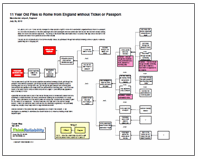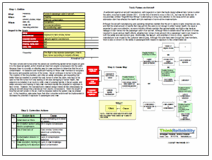By Kim Smiley
On September 30, 2013, an unoccupied train collided head on with another train sending 30 people to the hospital in Chicago. In a nod to the season and the bizarre circumstances of the accident, the unoccupied train has been colorfully dubbed “the ghost train”.
So what caused the “ghost train” and how did it end up causing a dangerous train collision? Investigators from the National Transportation Safety Board (NTSB) are still reviewing the details of the accident, but some information is available. An initial Cause Map, or visual root cause analysis, can be built to capture what is already known and can be expanded to incorporate more information as the investigation progresses. A Cause Map is built by asking “why” questions and documenting the answers to visually lay out all the causes that contributed to an accident to show the cause-and-effect relationships from left to right.
In this example, the trains collided because an unoccupied train began moving and the safety systems in place did not stop the train. Investigators still haven’t determined exactly what caused the train cars to move, but a key piece of the puzzle is that there was still power to the cars while they were being stored in a repair terminal awaiting maintenance. The NTSB believes that it was common practice to leave power to cars so that the lights could be used to illuminate the terminal. Workers used the lights to discourage graffiti and vandalism because the terminal was located in a high crime neighborhood.
Investigators will need to not only determine why the train started rolling, but also learn more about why the safety systems didn’t prevent the accident. Before colliding with another train, the unoccupied train traveled through five mechanical train-stop mechanisms, each of which should have stopped a train without a driver. Emergency brakes were applied at each train-stop that caused the train to pause momentarily, but then it started moving because the setting on the master lever caused the train to restart. Review of the safety systems will need to be part of the investigation to ensure that adequate protection is in place to prevent anything similar from occurring again.
The NTSB investigation is still ongoing, but the NTSB has stated that de-energizing propulsion power and using an alternate brake setting could help prevent unintended movement of unoccupied train cars. Additionally, the NTSB believes the use of a wheel chock and/or derail would ensure that a train stopped by a mechanical train stop mechanism remains stopped. Based on the information already uncovered, the NTSB has issued an urgent safety recommendation to the Federal Transit Authority (FTA). The NTSB recommended that the FTA issue a safety advisory to all rail transit properties to review procedures for storing unoccupied train cars to ensure that they were left in a safe condition that wouldn’t allow unintended movement and to ensure that they had redundant means of stopping any unintended movement. There is more information that is needed to fully understand this accident, but these precautions would be effective solutions that can be quickly implemented to reduce the risk of train accidents.




